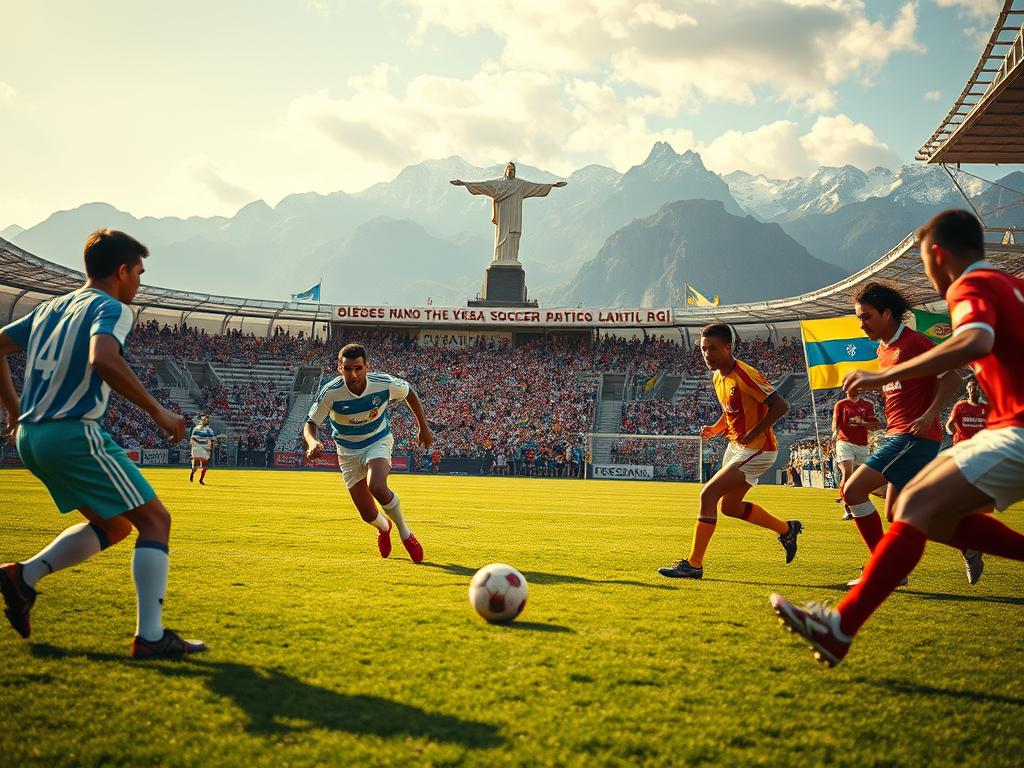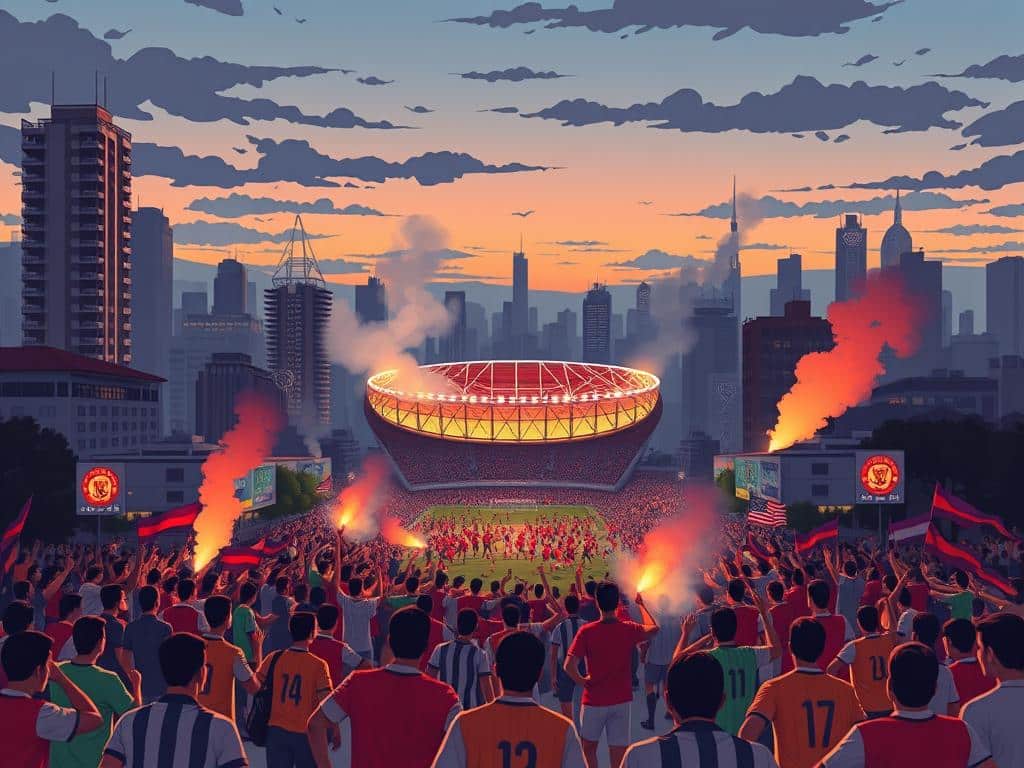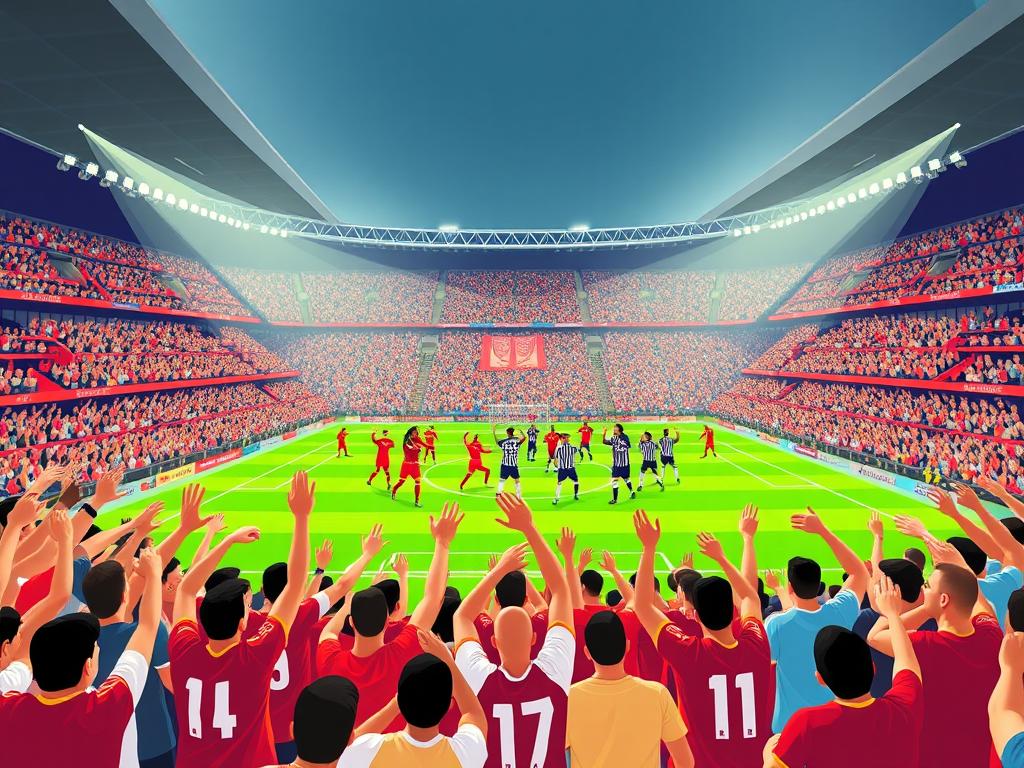Did you know the Copa America tournament began in 1916, making it older than the FIFA World Cup? This fact alone highlights the deep-rooted passion for soccer in South America. The sport isn’t just a game here—it’s a way of life, woven into the fabric of its culture.
From the bustling streets of Buenos Aires to the iconic stadiums, soccer has shaped communities and created unforgettable moments. European influences merged with local traditions, giving birth to a unique style of play that continues to captivate fans worldwide.
This blog dives into the rich legacy of soccer in South America. We’ll explore its evolution, iconic matches, and the cities that became its heartbeat. Get ready to uncover the stories behind the sport that unites millions.
The Origins of Soccer in South America
The roots of soccer in this region trace back to the late 1800s. European sailors and railway workers brought the game to port cities like Buenos Aires. These early influences laid the foundation for a sport that would soon captivate the entire country.
The Role of Early European Influences
British immigrants played a key role in introducing soccer. They organized informal matches and established the first clubs. By the second half of the 19th century, the sport began to spread rapidly.
Local communities quickly embraced the game. Soccer became a symbol of modernity and cultural integration. It was more than just a sport—it was a way to connect with the world.
Cultural Adoption in Port Cities
Port cities like Buenos Aires became hubs for soccer’s growth. The sport thrived in these vibrant, multicultural environments. Early clubs and matches reflected the diverse backgrounds of their players.
By the turn of the century, soccer had become a national passion. It united people across social and economic divides. This early adoption set the stage for the sport’s enduring legacy in the region.
Early Formation of Soccer Clubs and Leagues
Local passion for the game quickly transformed into organized clubs and leagues. In the late 1800s, the Buenos Aires Football Club became one of the first official teams in the region. These early clubs were more than just groups of players—they were symbols of community pride.
Informal matches soon gave way to structured competitions. By the early 1900s, local leagues began to take shape. This shift marked the beginning of a new era for football, as it moved from the streets to organized venues.
The rise of clubs set the stage for national tournaments. These events brought teams together, fostering rivalries and camaraderie. The success of these leagues also fueled interest in international competitions like the World Cup.
Community support played a vital role in this evolution. Fans rallied behind their local clubs, creating a sense of unity. This grassroots passion helped build the foundations of modern football in the region.
Historical Milestones and Pioneering Matches
The journey of soccer in Argentina began with a historic match in 1867, setting the stage for a cultural revolution. This game, held at the Buenos Aires Cricket Club Ground, was the first recorded football match in the region. It marked the beginning of a sport that would soon dominate the hearts of millions.
From these early days, the game evolved rapidly. Informal matches gave way to organized play, and local clubs began to form. These clubs became the backbone of the sport, fostering community pride and competitive spirit. The growth of soccer was unstoppable, and it quickly became a national obsession.
First Recorded Games in Argentina
The first official match in 1867 was a turning point. It showcased the potential of the sport to unite people. Over time, more matches followed, each contributing to the game’s popularity. These early games laid the foundation for the competitive landscape we see today.
Key matches in the late 1800s and early 1900s helped cement soccer’s place in Argentine culture. These events were more than just games—they were moments of national pride. They inspired generations of players and fans, shaping the future of the sport.
By the early 20th century, soccer had become a defining part of Argentine identity. The passion for the game continues to thrive, thanks to those pioneering matches that started it all.
British Influence on South American Soccer
British pioneers played a pivotal role in shaping the game we love today. In the late 1800s, British players and teams brought their expertise to the region, introducing advanced techniques and organized play. Their influence laid the foundation for the sport’s rapid growth.
Key figures like Charles Miller were instrumental in this transformation. Miller, a British expatriate, introduced formal rules and organized matches in Brazil. His efforts inspired local clubs to adopt structured play, blending British tactics with local flair.
British-led tours in the early 1900s further accelerated the sport’s development. These matches showcased high-level play and inspired local teams to improve. The tours also fostered a sense of competition, leading to the formation of new clubs and leagues.
Here are some key impacts of British influence:
- Introduction of advanced techniques and strategies.
- Formation of local clubs inspired by British models.
- Blend of British discipline with regional creativity.
By the early 20th century, British contributions had helped establish a professional framework for the sport. This legacy continues to shape the game, making it a global phenomenon. The FIFA World Cup, for example, owes much to these early efforts.
British influence also extended to coaching and training methods. Local players adopted these techniques, enhancing their skills and performance. This blend of styles created a unique playing identity that still defines the region today.
In summary, British pioneers left an indelible mark on the sport. Their contributions not only shaped the game but also inspired generations of players and fans. The legacy of their influence remains a cornerstone of football’s rich history.
Evolution of Soccer in Brazil’s Iconic Culture
Brazil’s journey to becoming a soccer powerhouse began with a single match in 1895. This historic game marked the start of a cultural phenomenon that would define the nation. From humble beginnings, Brazil transformed into a global giant, thanks to passion, innovation, and key contributors like Charles Miller.

Charles Miller’s Impact on the Game
Charles Miller, a British expatriate, introduced football to Brazil in 1894. He brought the first football and organized matches, laying the foundation for the sport’s growth. His efforts inspired local clubs to adopt structured play, blending British tactics with Brazilian creativity.
Miller’s influence extended beyond the field. He helped establish the São Paulo Athletic Club, one of Brazil’s first football teams. This marked the beginning of a structured approach to the game, setting the stage for the rise of professional clubs.
The Rise of Professional Clubs
By the early 1900s, professional clubs began to emerge. Teams like São Paulo and Fluminense became symbols of national pride. These clubs fostered local talent and created a competitive environment that pushed the sport forward.
The development of professional leagues was a game-changer. It provided a platform for players to showcase their skills and brought fans together. This grassroots passion helped Brazil’s national team become a dominant force on the world stage.
Here are some key milestones in Brazil’s soccer evolution:
- Introduction of structured development programs.
- Formation of iconic clubs like São Paulo and Fluminense.
- Rise of the national team as a global contender.
Brazil’s soccer culture is a blend of passion and innovation. From Charles Miller’s early efforts to the rise of professional clubs, the nation’s journey is a testament to its enduring legacy. Today, Brazil’s national team continues to inspire fans worldwide, proving that soccer is more than just a game—it’s a way of life.
Integration of Soccer into South American Society
From its colonial roots, soccer grew into a unifying force across the continent. What began as a pastime for the elite soon became a national obsession, shaping communities and fostering pride. The sport’s journey from the sidelines to the center stage is a story of passion and transformation.
In the early days, soccer was played in exclusive clubs. But it didn’t take long for the game to capture the hearts of the masses. Local matches became the heartbeat of neighborhoods, bringing people together. These games weren’t just about competition—they were about identity and belonging.
National pride soared as teams from the region competed in global tournaments like the FIFA World Cup. Victories on the international stage united entire nations, creating moments of collective joy. The sport became a symbol of hope and resilience, especially in challenging times.
Soccer’s impact extended beyond the field. It provided opportunities for social mobility, allowing talented players to rise above their circumstances. Clubs like Vasco da Gama broke barriers by recruiting local talent, regardless of background. This inclusivity strengthened communities and inspired future generations.
From bustling cities to rural villages, soccer became a shared language. It bridged divides and brought people together, proving that the beautiful game is more than just a sport—it’s a way of life.
Role of Youth Programs and Community Clubs
Grassroots soccer programs have long been the backbone of developing future stars. From neighborhood fields to professional stadiums, these initiatives have nurtured talent that went on to dominate the world stage. Youth programs and community clubs provide the foundation for competitive play, offering aspiring players the chance to refine their skills and gain exposure.
Community clubs often start as informal gatherings but grow into vital hubs for the sport. They create opportunities for young players to participate in local tournaments, which are essential for skill development. These events not only prepare players for higher levels of competition but also foster a sense of belonging and pride.
Youth programs have a profound impact on nurturing local talent. They provide structured training and access to resources that might otherwise be unavailable. Many professional players credit their early experiences in these programs for their success. The game becomes more than just a pastime—it becomes a pathway to achieving dreams.
Here are some key ways youth programs and community clubs shape the sport:
- They offer structured training and mentorship for young players.
- Local tournaments provide a platform for skill development and exposure.
- Community involvement ensures the sport remains accessible and inclusive.
Success stories from clubs that began as informal gatherings are inspiring. These clubs often start with a simple goal: to bring people together through the love of the game. Over time, they evolve into breeding grounds for future stars, proving that grassroots efforts can have a lasting impact.
Community involvement is crucial in sustaining the sport. From volunteers to local sponsors, these efforts ensure that soccer remains a vibrant part of neighborhoods. The passion and dedication of these individuals help keep the spirit of the game alive, inspiring the next generation of players and fans.
International Tournaments and Their Influence
The Copa América stands as a testament to the enduring spirit of competition in the region. Since its inception in 1916, it has grown into one of the most prestigious tournaments in the world. This event not only showcases top talent but also unites nations in a shared passion for the game.
The Inception of Copa América
The first Copa América was held in Argentina in 1916, making it the oldest national team competition in the world. Organized by CONMEBOL, it brought together teams from across the continent. The tournament was a celebration of skill and camaraderie, setting the stage for future events.
Over the years, the Copa América evolved from a simple gathering to a highly organized event. Milestones like the 1991 format change streamlined the tournament, making it more competitive. Teams like Argentina and Uruguay have dominated, each winning 15 titles, a record that highlights their legacy.
Impact on National Identity
International tournaments like the Copa América have played a crucial role in shaping national pride. Victories on the field often translate into moments of collective joy for entire nations. For example, Argentina’s 2021 win after a 28-year drought was a moment of immense celebration.
These events also reinforce a nation’s status on the global stage. Success in the Copa América has led to increased recognition for players and teams. It’s more than just a game—it’s a source of unity and identity for millions.
From its humble beginnings to its current place as a global phenomenon, the Copa América continues to inspire. It’s a reminder of how sport can bring people together, transcending borders and differences.
Defining the south american soccer history Through World Cup Triumphs
The FIFA World Cup has been a stage where South American teams have shone brightest, defining their legacy. From Brazil’s record-breaking five titles to Argentina’s dramatic victories, these triumphs have shaped the continent’s football narrative. The style of play, marked by creativity and flair, has become a hallmark of South American teams.
Brazil’s dominance began in 1958, when a young Pelé led the team to their first World Cup win. This victory not only established Brazil as a football powerhouse but also introduced the world to the samba style. Over the century, Brazil continued to impress, winning titles in 1962, 1970, 1994, and 2002. Their success has made them the most decorated team in World Cup history.
Argentina’s journey to glory includes three World Cup wins, with the 1986 tournament being particularly iconic. Diego Maradona’s “Hand of God” and “Goal of the Century” moments are etched in football lore. These victories have solidified Argentina’s place as a football giant and inspired generations of players.
Uruguay, though smaller in size, has made a significant impact. They won the inaugural World Cup in 1930 and claimed their second title in 1950. The latter victory, known as the “Maracanazo,” remains one of the most shocking upsets in football history.
Key moments that defined South American football:
- Brazil’s 1970 team, often regarded as the greatest of all time.
- Argentina’s 2022 World Cup win, ending a 36-year drought.
- Uruguay’s 1950 triumph, defeating Brazil in their own backyard.
These victories have not only brought pride to their respective american country but also influenced the global game. The style of play, characterized by technical skill and attacking flair, continues to inspire teams worldwide. Over the century, South American teams have proven that football is more than just a sport—it’s a way of life.
Celebrating Legendary Players and Coaches
From the pitch to the sidelines, iconic figures have shaped the way we see and play football today. These legends didn’t just win titles—they inspired millions with their passion and innovation. Their stories are a testament to the enduring spirit of the game.

Carlos Bilardo, a visionary coach, led Argentina to World Cup glory in 1986. His tactical genius and leadership transformed the team into a global powerhouse. Bilardo’s legacy continues to influence modern coaching strategies.
Telê Santana, another legendary man, is celebrated for his attacking style and commitment to beautiful football. His work with Brazil’s national team in the 1980s left an indelible mark on the sport. Santana’s philosophy of creativity and flair remains a cornerstone of Brazilian football.
Here are some key contributions from these icons:
- Bilardo’s tactical innovations earned him the title of one of the greatest coaches in history.
- Santana’s teams were known for their attacking play, inspiring future generations of players.
- Both men strengthened their national associations, leaving a lasting impact on the sport.
Their achievements go beyond titles and trophies. They shaped the culture of football, proving that the game is about more than just winning. Their leadership and style continue to inspire players and fans alike.
Football’s greatest moments often come from the brilliance of its most celebrated icons. These legends remind us why we love the game—it’s a blend of skill, passion, and human connection.
Rivalries, Matches, and Iconic Club Competitions
The thrill of rivalries has always been at the heart of the game, shaping its legacy. From club derbies to national showdowns, these contests have fueled unforgettable moments on the field. They’re not just games—they’re battles that define eras and inspire generations.
One of the fiercest rivalries is the Superclásico between Boca Juniors and River Plate. This clash paralyzes Argentina, with fans filling stadiums and streets. The intensity on the field mirrors the passion in the stands, making it one of the most watched derbies globally.
Another legendary matchup is the Paulista Derby between Corinthians and Palmeiras. With fanbases in the tens of millions, this rivalry transcends the field. It’s a cultural phenomenon that unites and divides cities, showcasing the sport’s deep-rooted influence.
Historic championships have also produced dramatic moments. The 1986 FIFA World Cup quarter-final, where Diego Maradona’s “Hand of God” goal stunned England, remains iconic. Such moments remind us why the championship stage is where legends are made.
Here are some key rivalries and their impact:
- Superclásico: Boca Juniors vs. River Plate, a rivalry that defines Argentine football.
- Paulista Derby: Corinthians vs. Palmeiras, a clash of Brazil’s most supported teams.
- Derby of the Millions: Vasco vs. Flamengo, a battle of fanbases and pride.
These rivalries extend beyond the field, shaping identities and fostering unity. They’ve become a testament to the sport’s ability to bring people together, even in the heat of competition. The influence of these matches is felt in every corner of the game.
From historic championship wins to unforgettable derbies, these contests have left an indelible mark. They remind us that football is more than just a game—it’s a shared passion that transcends borders and generations.
Tactical Innovations and Coaching Strategies
Coaching strategies have reshaped the way the game is played across the continent. From the early days of simple formations to today’s complex systems, tactical innovation has been a driving force. These changes didn’t just happen—they were a response to evolving competition and social conditions.
In the region, coaches have always been at the forefront of adapting to new challenges. Whether it’s blending local creativity with European techniques or introducing data-driven strategies, their impact is undeniable. The result? A dynamic style of play that continues to captivate fans worldwide.
Evolution of Playing Styles
The journey of tactical innovation began with basic formations like the 2-3-5. Over time, coaches in the region introduced more flexible systems. The 4-2-4 formation, for example, led Brazil to World Cup glory in 1958. This shift emphasized attacking play while maintaining defensive balance.
European influences also played a role. The Dutch “total football” system inspired coaches to rethink player roles. In South America, this led to a focus on positional interchangeability. Players became more versatile, adapting to multiple roles during a match.
Here are some key tactical shifts that transformed the game:
- Introduction of zonal defending to counter traditional man-marking.
- Use of wingbacks in the 3-5-2 formation to strengthen midfield play.
- Emphasis on pressing and high-intensity defensive systems.
These changes weren’t just about winning matches. They were about creating a style that reflected the region’s identity. The blend of creativity and discipline has made South American football a global benchmark.
Coaching strategies have also evolved with technology. Data analytics now plays a crucial role in shaping tactics. From player tracking to set-piece analysis, coaches use every tool to gain an edge. This modern approach ensures the continent remains at the forefront of the sport.
In conclusion, tactical innovation is the backbone of football’s success in this region. It’s a story of adaptation, creativity, and relentless pursuit of excellence. The game continues to evolve, and so do the strategies that define it.
Socio-Economic Impact on the Sport
Soccer’s rise in South America has been more than just a game—it’s a social and economic force. From local pitches to national pride, the sport has shaped lives and livelihoods in profound ways. Its growth has created pathways for change, uniting communities and fueling economies.
One key fact is how soccer provided opportunities for social mobility. Many players from underprivileged backgrounds rose to fame, transforming their lives. Clubs and academies became gateways for talent, offering a chance to escape poverty and achieve dreams.
Local economies also benefited from the sport’s popularity. Stadiums, events, and tourism brought in revenue, creating jobs and boosting businesses. The pitch became a hub for economic activity, from vendors to hospitality services.
Here are some ways soccer impacted communities:
- It fostered local pride, turning neighborhoods into vibrant centers of culture.
- Urban development surged as stadiums and facilities were built.
- Underprivileged groups found new opportunities through training programs.
However, challenges remain. While soccer has driven progress, issues like inequality and environmental concerns persist. Balancing growth with sustainability is crucial for the sport’s future.
Another fact is how soccer influenced national identity. Victories on the field united entire nations, creating moments of collective joy. The sport became a symbol of hope and resilience, especially during tough times.
From grassroots programs to professional leagues, soccer has been a catalyst for change. It’s more than just a game—it’s a way to build communities, empower individuals, and drive economies forward. The opportunity it provides continues to inspire generations, proving its lasting impact.
Latin American Soccer on the Global Stage
Latin America has long been a powerhouse in global football, setting the stage for unforgettable moments. From the world cup final to iconic rivalries, the region’s teams have left an indelible mark on the sport. Their unique style, blending creativity and passion, continues to captivate fans worldwide.
The uruguay argentina rivalry is one of the most storied in football history. Their clashes in international tournaments have produced some of the sport’s most dramatic moments. These matches are more than just games—they’re battles that define eras and inspire generations.
Here are some key achievements that highlight Latin America’s dominance:
- Brazil’s record-breaking five world cup final victories, including their iconic 1970 team.
- Argentina’s dramatic wins, such as the 1986 tournament led by Diego Maradona.
- Uruguay’s historic triumphs in 1930 and 1950, solidifying their place in football lore.
The region’s influence extends beyond the pitch. The unique style of play, marked by flair and technical skill, has inspired teams globally. Players like Pelé, Maradona, and Messi have become household names, showcasing the talent nurtured in latin america.
International recognition has also fueled national pride. Victories in tournaments like the world cup final unite entire nations, creating moments of collective joy. These achievements have reshaped football, proving that the sport is more than just a game—it’s a way of life.
From the uruguay argentina rivalry to Brazil’s dominance, Latin America’s football legacy is unmatched. Their contributions have not only enriched the sport but also inspired millions worldwide. The region’s passion and skill continue to define the beautiful game.
Future Trends and Opportunities in the Sport
The future of football in Latin America is brimming with potential, driven by innovation and emerging talent. From tactical advancements to technological breakthroughs, the game is evolving faster than ever. This evolution isn’t just about winning matches—it’s about shaping the next generation of players and fans.
One of the most exciting trends is the rise of data-driven strategies. Coaches are now using analytics to fine-tune tactics and player performance. This approach is transforming how teams prepare for big games, including the World Cup final. Expect to see more clubs adopting these methods to stay competitive.
Emerging talents from Argentina and Brazil are also making waves. Young players are breaking into top leagues, showcasing the region’s ability to produce world-class stars. These athletes bring a unique blend of creativity and skill, ensuring that Latin American football remains a global force.
Here are some key opportunities for growth:
- Investment in youth academies to nurture future stars.
- Expansion of local leagues to attract international audiences.
- Integration of advanced training methods to enhance player development.
The 2026 World Cup, co-hosted by the US, Canada, and Mexico, is another game-changer. This event will likely boost infrastructure and fan engagement across the region. It’s a chance for Latin America to showcase its passion and talent on the biggest stage.
New coaching strategies are also reshaping the game. From pressing systems to flexible formations, these innovations are setting new standards. Coaches are blending traditional styles with modern techniques, creating a dynamic and exciting brand of football.
As we look ahead, the possibilities are endless. The sport is more than just a game—it’s a platform for unity, innovation, and inspiration. Let’s embrace these trends and work together to build a brighter future for football in Latin America.
Final Reflections on Passion, Legacy, and Triumph
The legacy of football in this region is a story of passion, triumph, and cultural unity. From local clubs to international stage, the game has shaped communities and inspired generations. Its rich history is filled with iconic moments that continue to resonate with fans worldwide.
Key milestones, like the first World Cup victories and the rise of legendary players, highlight the sport’s enduring impact. These triumphs are more than just wins—they’re moments of collective joy that unite nations. The emotional connection to the game is unmatched, making it a cornerstone of cultural identity.
Every stage of development, from grassroots programs to global tournaments, has contributed to this legacy. The sport’s ability to bring people together, regardless of background, is a testament to its power. It’s more than just a game—it’s a way of life.
As we celebrate past achievements, let’s also look to the future. The passion for football continues to grow, offering endless opportunities for new stories and triumphs. Let’s keep the spirit alive and honor the legacy that has defined this beautiful game.







